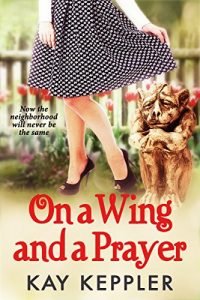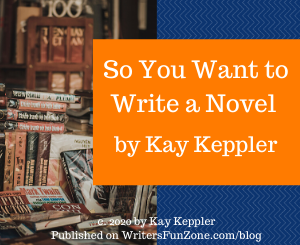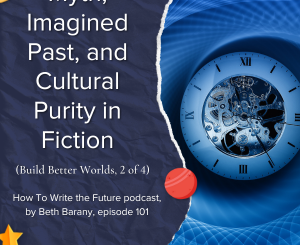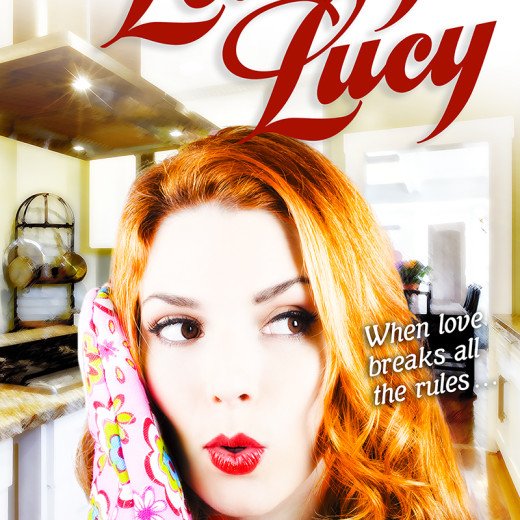Your Plot: It’s Not Just What Happens by Kay Keppler
 Let’s welcome back monthly columnist, editor, and novelist, Kay Keppler, as she shares with us “Your Plot: It’s Not Just What Happens.” Enjoy!
Let’s welcome back monthly columnist, editor, and novelist, Kay Keppler, as she shares with us “Your Plot: It’s Not Just What Happens.” Enjoy!
***
Back when I was in an MFA program, our instructor had us watch this video.
Longer versions of this presentation exist, but this two-minute film gives you the idea.
For those of you who skip the video, here’s what it’s about: the writers of South Park explain to a class of NYU students how they write the series. They say it’s about “but” and “therefore,” never “and then.”
Trey Parker and Matt Stone mention that each episode of South Park has thirty scenes, and those scenes aren’t just any action scenes that happen in a sequence. Each scene must be connected to the next by cause and effect (the but and therefore). The action of the second scene is a consequence of the action in the first.
Plot Comes From Consequences
For example, let’s say your story starts like this: “Maribel tried to shove open the barn door.”
Therefore, as a consequence, your second scene might start: “She picked up a rock and smashed the lock.”
And then, therefore, as a consequence, your third scene might start: “Farmer Joe ran after her with a pitchfork.”
Each action after the first one is a consequence of what happened in the scene before it. The implied therefore is the choice the character makes that sets up the next goal and scene.
Advance The Action and Build Your Plot
Another way to advance the action and build your plot is to connect your scenes with a metaphorical or literal “but”—a contradiction that demonstrates conflict.
For example: “Farmer Joe saw the damage Maribel did to his barn and ran after her with a pitchfork, but Maribel threw a bale of hay at him and escaped on the tractor.”
The situation Maribel found herself in—chased by an angry farmer with a pitchfork—forced her to make a choice.
In this case, would she fight or surrender?
With a “but” construction, your characters make choices about the conflict in their path, which leads to reaction (what will Farmer Joe do now?) and then the next action.
What Doesn’t Work in Building Plot
What doesn’t work in building plot, as Parker and Stone say, is writing scenes that could connect with an “and then.”
In these scenes, actions don’t depend on the actions of other characters.
There’s no response and no consequence.
For example: “Maribel tried to shove open the door. And then she saw a car swerve off the road.”
An “and then” scene sequence is random—it’s action, but it isn’t a story.
If you want, and you’re careful not to prolong it, you can use an “and then” to change the direction of your story.
For example:
Maribel tried to shove open the door, but it was locked.
Therefore, she smashed the lock.
Therefore, Farmer Joe ran after her with a pitchfork.
Therefore, Maribel escaped on the tractor.
And then she saw a car swerve off the road.
Therefore, she drove over to check it out.
But the sheriff arrested her.
The “and then” in this sequence brings the action to a halt—and that’s okay for the very short run, as long as you get back to the characters’ actions and the consequences of those actions.
One thing to look out for—it might seem that some actions are consequences because they can be tied with a “but” or a “therefore,” but in fact, they are not direct consequences.
For example:
Maribel tried to shove open the door, but it was locked.
Therefore, she smashed the lock.
Therefore, Farmer Joe ran after her with a pitchfork.
But he tripped and fell.
Farmer Joe’s falling—his failure to capture Maribel—had nothing to do with any action of Maribel.
For true conflict, when Farmer Joe chased Maribel, she needed to do something to save herself.
If she threw the bale of hay at him, and he tripped and fell, that works. But if he tripped and fell on the uneven ground of the pasture all on his own, that’s not conflict.
It’s all about cause and effect, but and therefore
Your story starts with an action, and your protagonist reacts to it, which forces the antagonist to respond to that. If an action doesn’t provoke a response, then that action is pointless to the plot. It isn’t moving the story.
To make your plot work, focus on what your protagonist does, his or her actions, rather than feelings.
Feelings are motivations. They aren’t plot.
Check out your scenes.
If you’ve linked them with but and therefore responses, then you probably have a sound plot that’s driving your story.
***
ABOUT THE AUTHOR
 Kay Keppler is an author Zero Gravity Outcasts, Betting on Hope, Gargoyle: Three Enchanting Romance Novellas, and editor of fiction and nonfiction –Angel’s Kiss and Outsource It!
Kay Keppler is an author Zero Gravity Outcasts, Betting on Hope, Gargoyle: Three Enchanting Romance Novellas, and editor of fiction and nonfiction –Angel’s Kiss and Outsource It!
She lives in northern California. Contact her here at Writer’s Fun Zone in the comments below, or at kaykeppler@yahoo.com to ask questions, suggest topics, or if you prefer, complain.
***
More popular articles by Kay Keppler on Writer’s Fun Zone:






